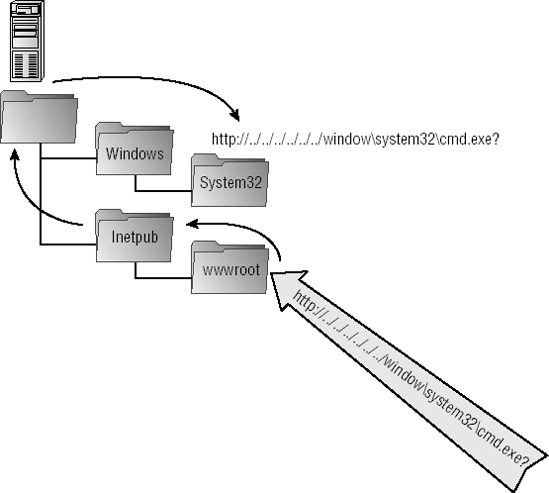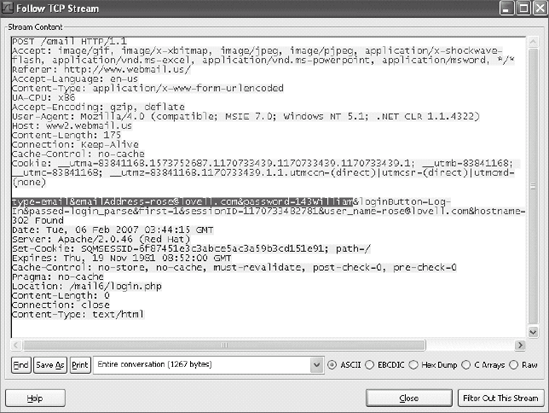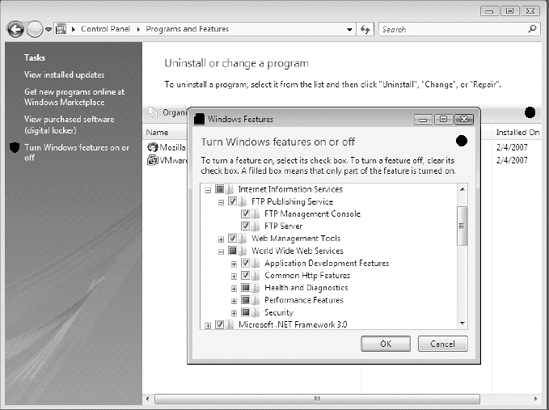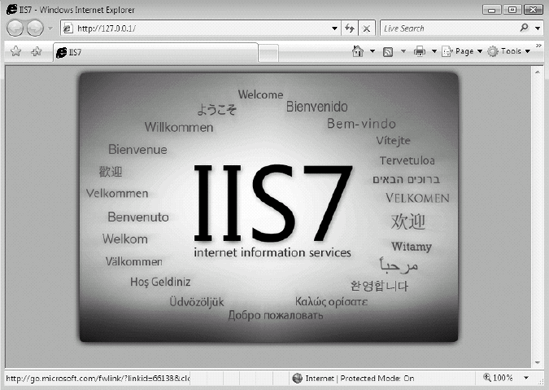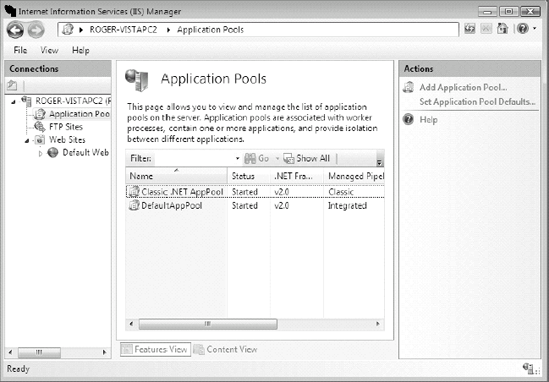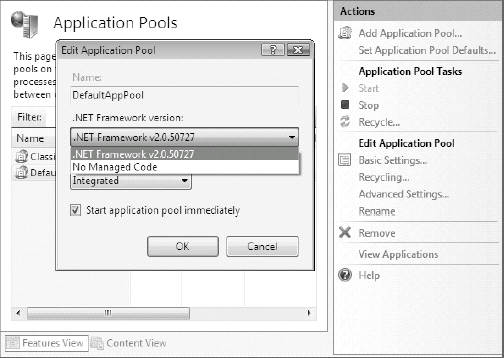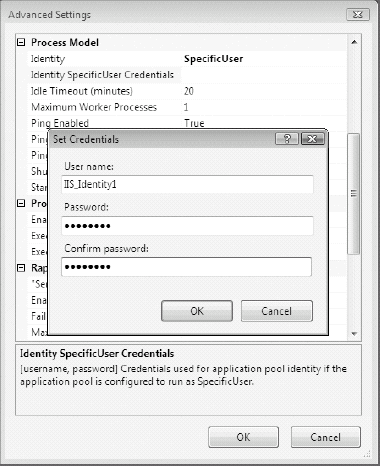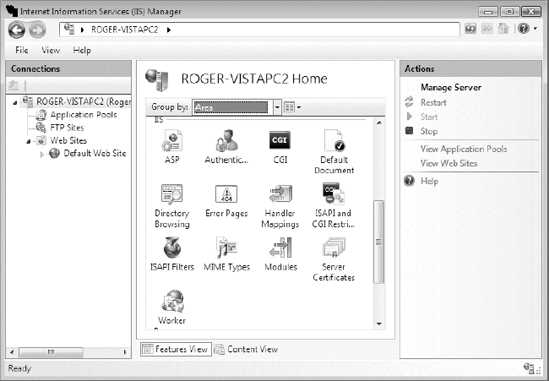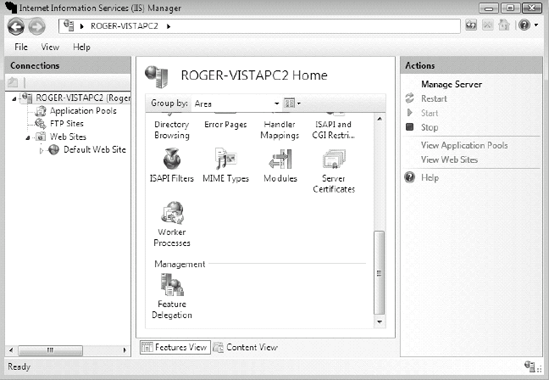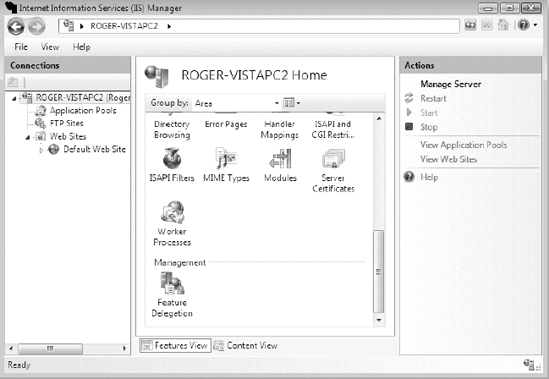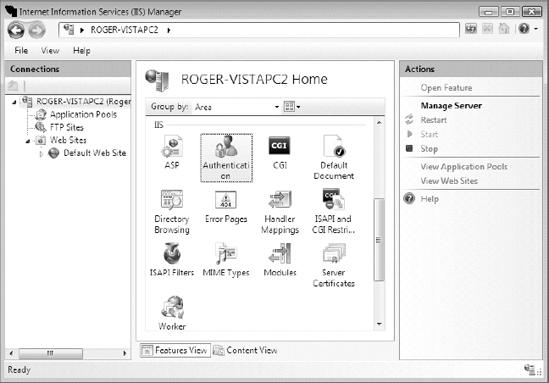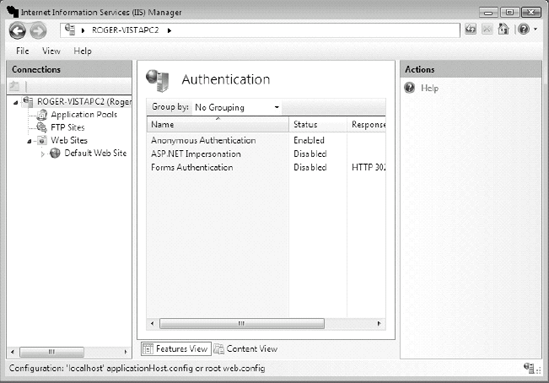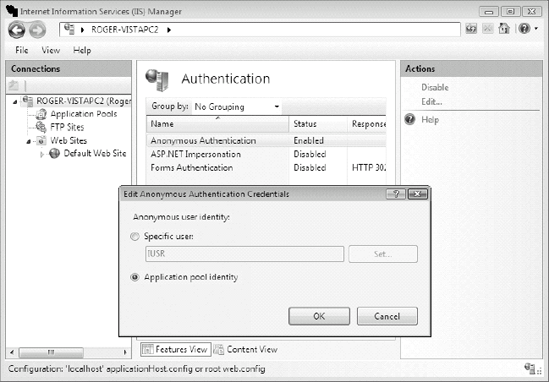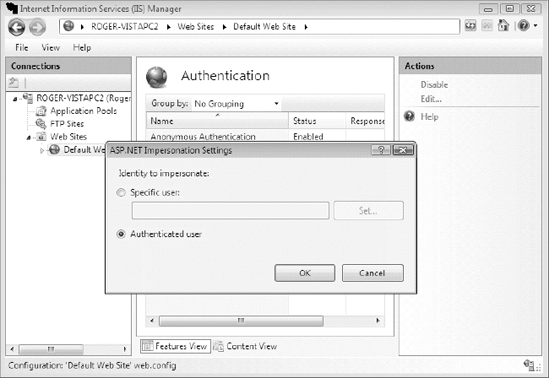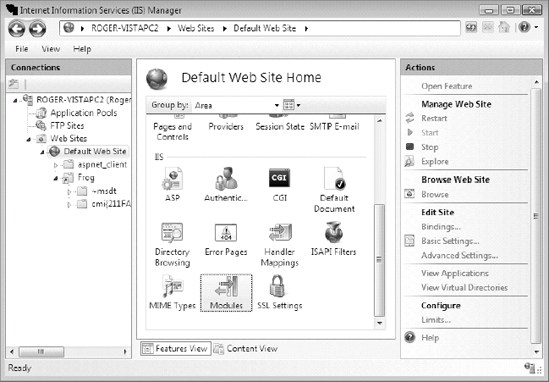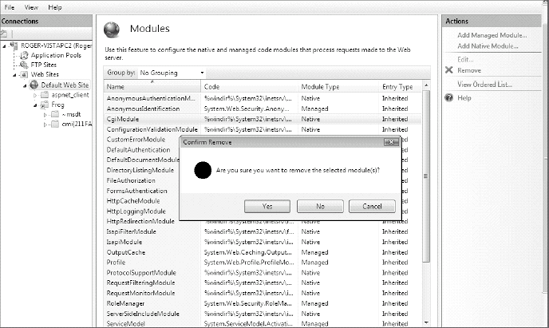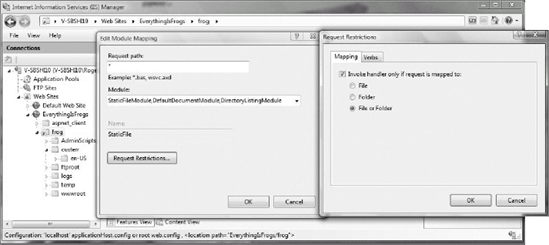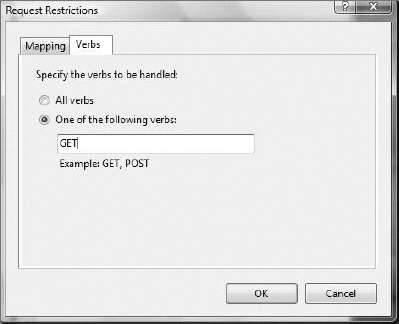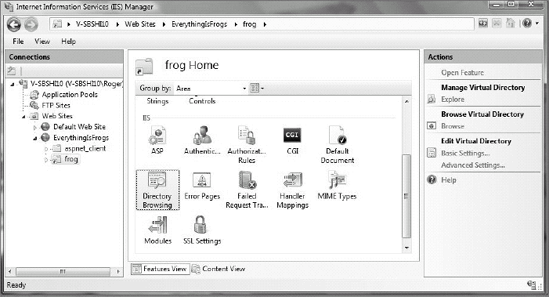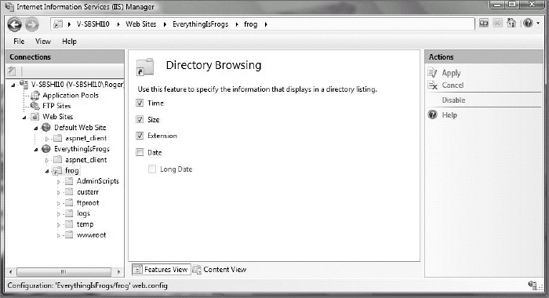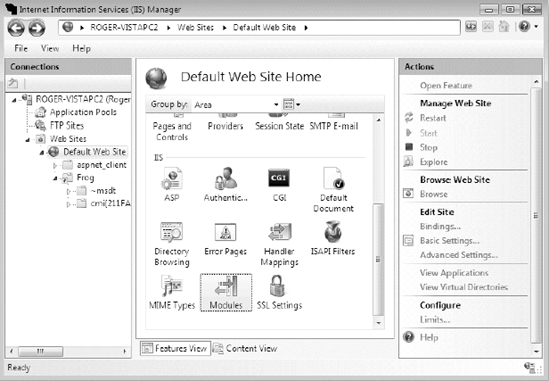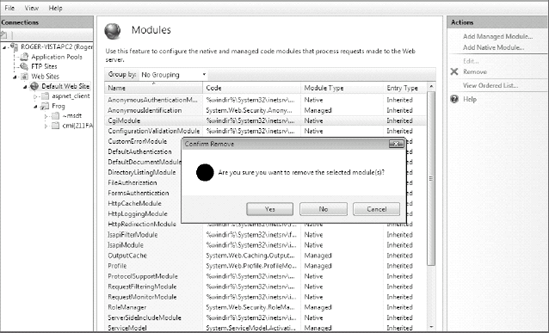Windows Vista introduces Internet Information Service (IIS) 7, built on Microsoft's highly successful IIS 6 product. After over four years (IIS 6 was released in March 2003 along with Windows Server 2003), IIS 6 remains without a single significant security blemish. IIS 7 was created to be even more secure. This chapter covers web server threats, introduces the new features and changes of IIS 7, and concludes with the ways to harden an IIS 7 server.
Note
IIS 7 is secure by default. This chapter's recommendations provide additional hardening steps applicable to any environment to make it even tougher to hack a web server. IIS 7 was specifically designed to be tough enough to serve as any type of web server, whether used internally as an intranet site or as an externally facing Internet-accessible web server. This chapter will cover hardening steps that can secure both types. However, IIS 7's original presence on Windows Vista, an end-user client OS, indicates that Microsoft intended IIS 7 to initially lean more toward intranet use.
Web servers contain many pieces and parts, including the host OS, web protocols, back-end databases, and the web server software itself. This collection of related components coupled with inviting inbound Internet connectivity makes web servers a frequent hacker target. Threats to web servers include the following:
Application vulnerabilities
OS vulnerabilities
Back-end database issues
Protocol vulnerabilities
Buffer overflows
Directory traversal attacks
Sniffing attacks
Denial of service
Password-guessing attacks
Each of those threat types is covered in slightly more detail in the material that follows.
Application vulnerabilities account for the vast majority of web server attacks. OS and web server vendors have worked hard to make their products less exploitable but, in general, application developers tend to be under trained in security. To be fair, most managers are more focused on delivering applications on time than with developing and testing the security defense of the application against some "theoretical" attack.
Note
When hiring a PHP programmer, I asked every one of the two dozens candidates what they did to ensure that the PHP code that they wrote or borrowed did not contain security vulnerabilities. To a person, all claimed to be unaware that PHP had any security issues. Only one candidate even seemed interested in the subject. He got the job. This is a real-world example of why web applications continue to be the most frequent target of hackers.
Application vulnerabilities are often caused by incorrect permission setting, scripting errors, design faults, inadequate input parameter checking, and by coding errors in general.
No software programmer is perfect. All programmers make design or coding errors. It's a factor of being human. Coding errors are often measured in bugs per thousands of lines of code (or bugs per kloc). The average number of bugs per kloc for a programmer is thought to be between 50–150/kloc, according to several studies. One study (www.sei.cmu.edu/news-at-sei/columns/watts_new/2004/3/watts-new-2004-3.htm) of 800 industrial programmers revealed in a 120 bugs/kloc average. The top 1 percent most accurate coders had 11 bugs/kloc.
Microsoft has worked hard to reduce the number of bugs through better programmer training, manual and automated code review, and financial incentives. According to David LeBlanc, Senior Software Development Engineer in the Office Division of Microsoft, the results are paying off. Microsoft believes their core programmers program to a 5 bugs/kloc standard, the best of any large company. Of course, Windows Vista contains over 50,000,000 lines of code. If you assume 5 bugs/kloc average, it means Vista could be estimated to have 250,000 programming bugs. Still, most of them are not security issues. They are more likely to be reliability and user-friendliness issues.
Proof of Microsoft's software quality engineering processes is that IIS 6 has had only three known bugs (as of April 2007) since its release in March 2003, and neither was used a lot in the wild. Microsoft SQL, often paired with IIS, hasn't had a major exploit since the SQL Slammer worm in April 2003, and even that bug had been patched for over six months before the worm got out.
All web server software runs on top of a host operating system. Accordingly, any successful attack against the underlying host OS is a successful attack against the web server. With the notable exception of OpenBSD (www.openbsd.org) every host OS has multiple vulnerabilities, including Windows. A web developer must take great care in hardening the underlying OS to minimize overall vulnerabilities.
Back-end databases, such as MS-SQL, MySQL, PostGres, and Oracle, are frequently the targets of intruder attacks because they often directly interface with front-end web servers. Although MS-SQL hasn't had a major system vulnerability in over three years, many other database suites, including Oracle and MySQL, have.
More often, application-level vulnerabilities (SQL injection attacks, scripting subsystem holes, and so on) allow the attacker to compromise the back-end database server and then use the data connection to compromise the web server.
Web servers use a number of network, transport, and session protocols. The two most popular protocols used are Hypertext Transfer Protocol (HTTP) and HTTP over SSL (HTTPS). However, it would not be an exaggeration to say that a web server can utilize dozens of other protocols (and file formats) to serve up a standard application. Each protocol and the subsystem that interacts with the client is a potential attack vector.
Even when the protocol doesn't have known public vulnerabilities, web developers can implement them insecurely. It is not uncommon for Web sites claiming to have HTTPS encryption and authentication to send all resulting data streams in clear-text and unauthenticated.
Note
I have often seen this mistake on some of the Web's most popular banking and financial Web sites.
Like any input-accepting application, web server software can be buffer overflowed. The most famous IIS buffer overflow was the Code Red worm of July 2001 (www.cert.org/advisories/CA-2001-19.html). Affecting IIS versions 4 and 5, its worldwide spread led to a major loss of consumer confidence in IIS. Microsoft responded by making the next release of IIS one of its most secure products in history. In over four years, only three holes have been found, none of which were used widespread.
The last one of those vulnerabilities (as of the book's publication date) was a buffer overflow exploit in July 2006 (www.microsoft.com/technet/security/Bulletin/MS06-034.mspx). IIS purists don't consider this an IIS buffer overflow because the exploit is located in the potentially separate ASP.NET subsystem. However, both products are made by Microsoft and are meant to be run together, although ASP.NET is not installed by default in IIS 6 unless intentionally enabled. Either way, it was not popularly exploited. Apache 2.0 web server, a popular open source web server, has had 4 buffer overflow vulnerabilities (out of 33 total known vulnerabilities) in roughly the same time period. Buffer overflows are a potential problem for all web servers.
Note
IIS's main executable, Inetinfo.exe, is protected by Data Execution Prevention (DEP), which will defeat many common buffer overflow attacks.
Directory traversal is an attack method in which the intruder uses malformed (or unexpected) input to "jump" out of the drive folder containing the web server program or application into more privileged areas. For instance, the default location for IIS application files is %Systemroot%inetpubwwwroot. A directory traversal attack would attempt to break out of the wwwroot folder into the root directory, Windows, or WindowsSystem32, where unauthorized access can be more successful and fruitful. Directory traversal attacks normally contain strings of characters (for example, http://../../../../../../../../) that attempt to confuse the web server into offering up an unauthorized default directory outside the normal web server boundary (see Figure 9-1). The attack allows the intruder to traverse various directories, go up to the root, and then back down into the drive's directory structure to execute contained commands.
Although IIS has not experienced a successful directory traversal attack in many years, such attacks used to be a frequent method of exploitation in the days of Windows NT and IIS 4.
Unless the Web site uses HTTPS, the traffic to and from the web server is often sent in plain text. If the attacker can intercept the network streams, information can be sniffed and analyzed. Figure 9-2 shows a login name and password sniff from an HTTP session. Many users do not realize how frequently their confidential information is transmitted in clear text across the Internet.
Denial of service (DoS) attacks have been a big threat to web servers. Attackers, using armies of compromised machines, can send millions of rogue packets per second to a web server, denying legitimate access and business. DoS attacks are among the most popular attacks against popular, commercial web servers, and are rather difficult to prevent. Indeed, in some sense, they are impossible to prevent, as every communication begins with a request that causes a response. If an attacker can cause more malicious requests to come in than the host machine can adequately respond to, a DoS attack occurs. With the rise of botnets, networks of computers exploited and controlled by hackers, Distributed denial of service (DDoS) attacks make it possible for attackers to bring down even sites with large bandwidth pipes.
Many Web sites, especially gambling and pornography sites, which make tens of thousands to millions of dollars a day from online customers, have been extorted by cyber criminals to pay up to $100,000 to avoid getting a targeted DoS attack. These Web sites find it cheaper to pay the ransom than to lose the business that would result from the DoS. While many security companies are developing better anti-DoS capabilities to protect popular Web sites, the default anonymous nature of the Internet makes stopping DoS attacks difficult. Microsoft has responded by intentionally hardening the Windows TCP/IP network stack against specific types of DoS attacks, improving IIS's performance under heavy loads, and in setting performance thresholds.
Many web servers are compromised because the administrators configure them with weak passwords. Most web servers contain either HTML-enabled logon screens or remote admin consoles. Attackers can often guess against these logon prompts using automated password guessing tools (such as Hydra) or by using manual methods. Even moderately complex passwords (for example, eight characters with multiple character sets) can be guessed by an attacker given enough time. Unfortunately, many web administrators don't even attempt to use long or complex passwords, so guessing the correct admin password doesn't take a significant amount of effort.
A great discussion of web server vulnerabilities is maintained at Open Web Application Security Project (OWASP) at www.owasp.org. Their top ten web server security errors list (www.owasp.org/index.php/OWASP_Top_Ten_Project) is a great list to review. While the list is terrific, it's depressing to see that the list hasn't changed much over the years, and it appears we are no closer to better securing web servers than we were in January 2003 (when the OWASP top ten list was first released). The next two sections will introduce IIS in general and then discuss the new features of IIS 7.
IIS is an application providing many network services, including World Wide Web (WWW) publishing, File Transfer Protocol (FTP), Network News Transfer Protocol (NNTP), Web Authoring Distributing and Versioning (WebDAV), Simple Mail Transfer Protocol (SMTP) virtual service, a web services platform, and many other applications and functionalities. It natively supports many languages and protocols, including HTTP, HTTPS, HTML, VBScript, JScript, ASP, and ASP.NET protocols and languages. Its default functionality can be extended using modules, .NET, ISAPI programs, handler programs, scripting, controls, SMTP, and more.
IIS was originally only installed on Microsoft's file server products, but starting with Windows 2000, was also available for enterprise workstation clients (for example, Vista Ultimate edition). IIS is not installed by default with Windows Vista, but can be installed or activated with minimal effort. When installed and activated, IIS installs with a bare minimum of services unless otherwise configured.
Note
In the past, IIS was not available on Home editions of Microsoft Windows, but IIS 7 is available on Windows Vista Home Premium Edition.
Table 9-1 shows popular IIS versions and their default operating systems.
IIS 7 builds upon IIS 6's excellent performance and security record, adding sweeping changes inside and out. The major new IIS 7 features include:
Granular, modular design and components
Reduced default install footprint
Replaced metadata config file with XML
New Admin tools
New troubleshooting and diagnostic tools
Integrated URL string filtering (you no longer need URLScan)
Hidden namespaces (you can hide folders from being accessed)
New authentication methods
Integrated form-based authentication
Authentication can be redirected to external sources (for example, SQL, Oracle)
Integrated ASP.NET and IIS authentication
Microsoft passport authentication is removed
Easier for Web site to run directly using worker process identity
Per Web site or application admin delegation
IUSR_computername (i.e., the IIS anonymous account) is deprecated, although it is now a built-in account with a well-known SID
IIS_IUSRS is a new built-in IIS group with a well-known SID for anonymous connections
IIS_WPG group is deprecated (although it will still appear on many installations)
Many new additional security features
These new features will be covered in more detail in the material that follows.
To install IIS 7, it must be manually added from the Control Panel using the Programs and Features applet, selecting Turn Windows features on or off, and selecting the appropriate components under Internet Information Service (see Figure 9-3).
There are over three dozen components and subcomponents to choose from when installing IIS. Table 9-2 discusses the various components. One of IIS 7's biggest improvements over previous versions is the granularity of the features that can be, or not be, installed. For instance, you can install Windows Authentication, but not Digest Authentication. If you don't install a particular component, like Digest Authentication, the associated programming coding is not installed or kept in memory. This decreases the potential security vector attack points and provides incremental performance benefits. Installers should choose the bare minimum number of components necessary to support their web server's applications. Unfortunately, the new level of granularity makes installing IIS a chore. You can choose between 48 different feature checkboxes over three levels. There is no "install all" setting. To get a complete IIS install takes 24 separate enabled checkboxes. Of course, you should only install the bare minimum requirements necessary to meet your web application needs. Use Table 9-2 as a guide.
Table 9-2. IIS Components
When IIS 7 is installed on Vista, the following components are installed by default if no specific components are selected:
IIS Management Console, default document
Directory browsing
HTTP errors
Static content
HTTP logging
Request Monitor
Static content compression
Request filtering
The default IIS 7 install will allow only static content to be delivered. All active scripting is disabled by default. IIS 7 can support multiple Web and FTP sites and, unlike previous workstation versions, can do so at the same time. Each separate Web or FTP Web site must be bound to a separate TCP port number, IP address, or host header name (which is identical to the existing behaviors in server versions of IIS). IIS 7 can support multiple Web and FTP site configurations. IIS application files are located in a folder called %windir%system32inetsrv. The initial IIS 7 install creates a default Web site called, not surprisingly, the default Web site. Files for the default Web site are stored in Inetpubwwwroot by default, and contain only a single static web page (see Figure 9-4) that, if clicked will redirect the user to www.iis.net, Microsoft's official IIS support Web site.
Enabling IIS activates a handful of new executables and one or more services. The core executeables will all run in Session 0 using the Local System account. Interfaces (for example, InetMgr.exe) typically run in additional sessions (for example, Session 1) under the local user's security context. The main IIS WWW service is called the World Wide Web Publishing Service service. The service is launched in a Svchost process called IISsvcs. The IIS Worker Process (W3wp.exe) will also be launched.
When IIS is active, the web server will listen only on port 80 until otherwise configured. IIS runs using a multitude of files and processes. The main IIS process of Inetinfo.exe, running in the Local System context, is always present, but several other processes assist. Some such as Dllhost.exe may appear and then disappear, until later needed. It's important to note that in IIS 6 and above, no user code runs in these highly privileged processes.
Note
If Vista Home Basic is upgraded to Business or Ultimate editions, several IIS 7 features are installed and enabled by default. See http://support.microsoft.com/kb/930902/en-us for more details.
A protocol listener is a software routine that listens on a predefined communication channel (and port), and passes transmitted data (called messages) to and from the participating server service and communicating client. IIS 7 includes five default protocol listeners: Http.sys, Net.tcp, Net.pipe, Net.p2p and Net.msmq; and additional custom listeners can be created and used. IIS 6 had only one — Http.sys. The other new protocol listeners support Microsoft's new Windows Communication Foundation web services. With the exception of Http.sys, the other listeners require .NET Framework installation and the Windows Process Activation Service (WAS), which runs in the same Svchost process as the WWW service. However, protocol listeners can be implemented using WAS and not require IIS.
Each listener runs in kernel mode, directly interacting with the operating system. Microsoft has thoroughly tested each protocol listener for security vulnerabilities, trying their best to ensure they are not susceptible to buffer overflows and other common security mistakes. Although finding every security vulnerability is almost impossible, Microsoft successfully defended IIS 6's Http.sys against every attacker for over 4 years, so they have a leading example to follow. Protocol listeners can be activated in an XML configuration file called ApplicationHost.config. To minimize possible attack vectors, only the protocol listeners needed should be activated. The follow sections summarize each protocol listener.
When IIS 7 is installed and active, the Http.sys kernel mode driver installs as the default HTTP protocol stack listener and intercepts and caches incoming HTTP requests. It also provides caching, logging, quality of service, and bandwidth throttling for the web server. Every active Web site registers itself with the HTTP protocol stack. The Http.sys driver includes built-in support for HTTPS, SSL, and TLS, instead of requiring a separate service (i.e., HTTP SSL), as was the case in IIS 6.
Net.Tcp is a protocol listener supporting a new feature called Net.TCPPort Sharing, a part of the Windows Communication Foundation (WCF). Like Http.sys, it allows multiple applications to share a single TCP network port. Http.sys relies on the HTTP protocol, whereas Net.Tcp can be used with any protocol over any TCP port, and with any application. Not enabled by default, the Net.Tcp Port Sharing service accepts inbound connections using the net.tcp protocol and forwards them to their destination application. URLs utilizing Net.Tcp will look something like net.tcp://x.x.x.x/default.aspx, and will always use the TCP protocol. The Net.Tcp Port Sharing Service service must be started for this protocol listener to work. The Net.Tcp Listener Adapter service must be enabled for the Net.Tcp listener to be able to forward to WAS.
The Net.Pipe protocol listener relies upon the Named Pipes protocol, which has long been a part of Microsoft Windows. The best short explanation of Named Pipes is that it is a file sharing and communication protocol for applications, much like NetBIOS/SMB is for users. Behind the scenes of many Windows applications, Net Pipes is used to communicate between different processes. Now Named Pipes can be used to interact with IIS and WAS, although it is reserved for local inter-process communications. The URL moniker for the Net.Pipe protocol listener is net.pipe://. The Net.Pipe Listener Adapter service must be active in order to use Net.Pipe services.
Peer-to-Peer (P2P) services were originally added to Windows XP Pro SP1 and later Windows operating systems. Windows Vista offers up new native P2P services and networking transports. The Net.P2P protocol listener can be used by clients by utilizing the URL moniker for the Net.P2P protocol listener of net.p2p://(for more information, see http://msdn2.microsoft.com/en-gb/library/system.servicemodel.netpeertcpbinding.scheme.aspx).
The Net.MSMQ protocol listener is useful for advanced applications requiring message queuing. Microsoft Windows includes a robust message queue handling service, which helps triage large amounts of incoming data and to ensure the completeness of complex transactions. Developers can create their own custom message queuing protocol listeners as well. Custom MSMQ protocol listeners normally have the name of msmq.<customname>. The URL moniker for the Net.Msmq protocol listener is net.msmq://. The Net.Msmq Listener Adapter service must be started in order for the Net.MSMQ protocol listener or any msmq customer listeners to be able to pass traffic to WAS.
IIS uses a combination of mechanisms to pull off what appears to be simple web hosting. It is essential that computer security workers understand the various parts behind the scenes of IIS in order to secure it.
IIS protocol listeners forward client requests to the associated Web site's worker process. In IIS 7.0, Windows Activation Service (WAS) manages application pool configuration and worker processes instead of WWW Service. The worker process is user mode–based code that does the actual handling, delivery, and response to the incoming request for a particular Web site. For example, a worker process may retrieve HTTP content and send it to the requesting client, call an ISAPI filter to handle a particular type of request, or run a scripting engine.
Each Web site runs in an application pool, which is a named worker process and logical memory allocation where one or more Web sites or applications reside. Application pools can be shared by Web sites and applications or used to isolate sites and applications from each other (more on this in the "Defending IIS" section later in this chapter).
When IIS 7 is installed, two application pools, called the DefaultAppPool and Classic .NET AppPool, are created (see Figure 9-5). IIS 6 did not have the latter application pool, but Classic .NET AppPool behaves in the same way as IIS 6's DefaultAppPool. Application pools can be configured to run with or without (i.e., no managed code) .NET Framework (see Figure 9-6). The Managed pipeline mode refers to whether the developer wants ASP.NET and non-ASP.NET requests to be processed together (i.e., Integrated), which is a new IIS 7 feature, or separately (i.e., Classic) using Aspnet_isapi.dll for the ASP.NET requests.
Additional application pools can easily be created, and each Web site and directory can belong to one or more application pools. Additional application pools can be created in IIS Manager by clicking the Add Application Pools option under Application Pools leaf object. Additional application pools can also be created using the command line as well. Here is the command and syntax:
appcmd add apppool /name:string/managedRuntimeVersion:.string/managedPipelineMode: Integrated | Classic
Placing different Web sites in different application pools isolates what corruption or damage can be done by one site to another. A web server administrator can run high-risk applications in their own application pool, separate from the main Web site. If a malicious action happens to a Web site in one application pool, the vulnerability does not immediately compromise Web sites in other application pools.
Note
When discussing how IIS works, application pools are often discussed as if they are the same as worker processes, even though they are not one and the same.
In IIS 7's default mode (called worker process isolation) there is a separate worker process for each application pool. Each runs in the W3wp.exe process, which runs in the Network Service security context by default. In previous IIS versions (or a Web site running in IIS 5 isolation mode), Dllhost.exe is the default single instance worker process for all Web sites. Applications and Web sites running in Low Application Protection mode (for example, ASP) use the Inetinfo.exe worker process, which as stated previously, runs in the Local System security context. This means that in previous versions of IIS, a single compromise could allow easy access to all Web sites on the server.
Note
The W3wp.exe process will not launch until a Web site on the web server is first accessed.
Note
In Vista, just as in previous Windows versions, Dllhost.exe can also be used by other applications, many of which are unaffiliated with IIS, so don't be surprised if you see it as an active process in memory.
Each worker process and associated application pool runs in the security context of an application pool identity. The identity is a user or service account used to run the worker process and application pool (i.e., the security context that the worker process and application pool run in). The default identity for both default application pools is Network Service.
Introduced in XP Pro, the Network Service account has permissions similar to the Authenticated Users group, but accesses network resources using the web server's computer account. The Network Service account has the following privileges:
Replace a process-level token
Adjust memory quotas for a process
Generate security audits
Bypass traverse checking
Access this computer from the network
Logon as a batch job
Logon as a service
Impersonate a client after authentication
You can choose the more secure Local Service account if your application pool does not need to access other network services or computers. The Local Service account, also introduced in XP Pro, has permissions similar to the Authenticated Users group, but accesses any network resources using an anonymous null session because it does not have the "Impersonate a client after authentication" privilege. In XP Pro and above, network resources cannot be accessed using a null session, except to domain controllers. The Local Service account has the following privileges:
Replace a process-level token
Adjust memory quotas for a process
Generate security audits
Bypass traverse checking
Access this computer from the network
Logon as a batch job
If a Web site doesn't need access to other network resources (i.e., besides the normal remote requesting clients), the Web site administrator can change the worker process identity to Local Service.
You can create or use a custom user or service account (i.e., Specific User) for the application pool identity (see Figure 9-7). The pool will then have access only to the resources and permissions of the custom identity account. If you create a custom identity account, add it to the IIS_IUSRS group, which assigns the necessary permissions and privileges to allow the account to function as an IIS application pool identity. You then need to add the other NTFS file and folder permissions to the resources used by the web application.
You can also choose the LocalSystem account for the identity if the application pool needs Administrator-level privileges and permissions. This is not recommended unless absolutely needed. If a hacker is successful in compromising a web application running in an application pool with the LocalSystem identity, he or she has far more potential to be damaging than if the application pool ran under Local Service or Network Service.
Note
In IIS 6, any application pool identity had to be added to a group called IIS_WPG to get the correct permissions. This group and requirement has been replaced by IIS IUSRS, although the previous group may still appear.
If the Web site using a custom application pool identity is also involved in delegation to another back-end server (for example, IIS front end authenticating users for an MS-SQL back-end database), a Service Principal Name (SPN) must be created for the custom identity. Specifically, the administrator can use Microsoft's SetSPN.exe utility (http://technet2.microsoft.com/WindowsServer/en/library/b3a029a1-7ff0-4f6f-87d2-f2e70294a5761033.mspx) to create the new SPN. The syntax would be similar to this for a Web site located at www.example.com using a custom user identity called custom in a domain called Contoso:
setspn.exe -A HTTP/www.example.com contosocustom
When a user connects to an IIS Web site, the files and content are accessed by IIS in the context of an impersonated user. Whatever permissions and privileges the impersonated user has, so too does the connecting Web site user. This is an extremely important point to remember when configuring IIS security. IIS allows authenticated and anonymous connections. Authenticated connections must use a valid SAM or Active Directory security principal account, or any one of those additional authentication types added in IIS 7, one mapped to an external source, such as SQL, Oracle, and so on.
When IIS 7 is installed, a default user account is created called IUSR _<com-putername>, where <computername> is the name of the computer where IIS is installed along with a new group called IIS_IUSRS. In the past, IUSR_<comput-ername> was the service account associated with any anonymous connection to the World Wide Web or FTP services. In IIS 7, the IUSR_<computername> account is deprecated. It has no default permissions and is included for backward-compatibility purposes only.
Any user or service account belonging to the IIS_IUSRS group (there are no default members) can now be used as the IIS anonymous account. By default, the IIS_IUSRS group has only Read & Execute permissions to the Inetpub wwwroot folder. Any authenticated user, by default, has Read & Execute permissions to Inetpub and Inetpubwwwroot. Additional NTFS permissions can be given to both anonymous and authenticated user accounts.
Both IUSR_computername and IIS_IUSRS are built-in accounts with "well-known" security identifiers (SIDS), much like Administrator and Administrators. This is new for IIS 7 and it allows Web sites and content to be copied or moved to other servers, and for the permissions this user and group had to remain. In the past, the user and group permissions had to be re-set any time the web server content was moved to a new server because new SIDs were referenced.
To recap, IIS 7.0 runs using a combination of one or more worker processes (W3wp.exe), and one or more protocol listeners, applications pools, or identities — all slave to the permissions granted to them for the related Web site content.
Figure 9-8 shows a theoretical example of IIS running three Web sites within two application pools, one using HTTP, the other using Named Pipes. An additional application is running using Net.tcp using WAS. Users accessing a particular Web site run its files in the context of an impersonated user, either by specifically authenticating or by indirectly using an IIS anonymous user account that is part of the IIS_IUSRS group (not to be confused with the completely unrelated anonymous null session built-in account).
Every aspect of IIS can be managed using command-line tools, and nearly as much with a completely revamped and improved IIS Manager GUI (see Figure 9-9). It separates the various aspects of web server administration into different categories (for example, IIS, ASP.NET, Web Server Management, Server Components, Security, Performance, Health, and so on).
Previous versions of IIS stored most settings in a proprietary file called the Metabase. It was difficult to edit, and even more difficult to transfer to other servers. In IIS 7, configuration settings are stored in two new XML files. The Application.Host.config file (located in %Windir%System32inetsrv config) stores IIS server settings and each Web site has its own Web.config file for site-specific settings. Developers can literally copy these files to other IIS servers to create duplicate Web sites, or start with a cloned-based copy.
IIS administrators can also use Remote Desktop or another third-party remote control tool (PC Anywhere, VNC, and so on). Remote Desktop uses the Remote Desktop Protocol (RDP) over TCP port 3389 to provide a reliable and encrypted communications session.
Note
The RDP client should be RDP client version 6.1 or later, which corrects an authentication problem that previously allowed man-in-the-middle attackers to read encrypted communications.
RDP and many other remote admin tools allow complete control of the web server, and not just IIS. Whatever remote admin tool is used, the administrator should take great pains to make sure the application, password, and connection port are secure.
One of the biggest past criticisms of IIS was that it was difficult to give an IIS developer the permissions and privileges he needed to manage the Web site, without giving him control over the entire server. Or it was difficult to configure IIS so that one user had complete control over her Web site, and did not have control on other Web sites located on the same IIS server.
IIS 7 solves this problem with Feature Delegation and Administrator Lists. Unfortunately, Vista contains only the first feature, which is only half the solution. Using Feature Delegation, web administrators can set what features are modifiable on a web server basis (this should be expanded to be configurable on a per Web site or per application basis in future IIS versions). It is standard in the Windows environment that the delegation set for parent objects is inherited by child objects. Longhorn server will contain the Administrator Lists, which will then allow each allowed or denied feature set to be tied to a particular user or group. For now, Vista users will have to be happy with Feature Delegation by itself.
To use Feature Delegation, the user must be an Administrator for the parent object being delegated (i.e., Administrator for server or web administrator for Web site or application pool). The administrator does the following:
1. Open up the IIS Manager console in Features View.
2. Click the web server leaf object.
3. Double-click the Feature Delegation icon under the Management pane (see Figure 9-10).
4. Choose the feature you wish to delegate (see Figure 9-11) and its default delegation state.
Each feature can then be set to one of four states:
Read Only (or Configuration Read Only)
Read/Write (or Configuration Read/Write)
Remove Delegation
Reset to Inherited
If a feature or configuration item is set to Read Only, it cannot be modified. If a feature or configuration option is set to Read/Write, it can be modified. Remove Delegation removes any specifically set previous delegation. Reset to Inherited lets the parent object's settings follow down into the child object for that feature.
The Feature Delegation affects only what can or can't be set using the IIS Manager GUI. The users wishing to read or modify the web server, Web site, or application pool must also have the desired NTFS permissions on the ApplicationHost.config file (for the web server) and/or Web.config (for the related Web site).
When a client machine connects to an IIS server, it will almost always connect as either an anonymous user (i.e., no user credentials supplied) or with supplied user account credentials. In IIS, user credentials can be stored in Active Directory or the local SAM, handled by an application, or stored in an external authentication database source. IIS allows seven different kinds of default authentication:
Anonymous
ASP.NET Impersonation
Basic Authentication
Digest Authentication
Forms Authentication
Windows Authentication
SSL/TLS Client Side Mapping (IIS and Active Directory)
Authentication methods can be configured in the IIS Admin tool by choosing the Authentication icon under the IIS pane (see Figure 9-12). One or more authentication methods can be selected per Web site, per folder, or per file (see Figure 9-13). For example, an administrator can allow anonymous connections to most of their Web site content, but require authenticated access to a particular folder or file. Disable or remove unused authentication methods.
Note
If anonymous and other authenticated methods are allowed at the same time, most browsers will try the anonymous connection first.
When a browser connects to IIS without supplying user credentials, which is often the case when a browser connects to a public Web site, IIS allows the user to access the Web site with the permissions assigned to the related IIS anonymous user account. Any account intended to be used as an IIS anonymous account should be in the IIS_IUSRS group.
Membership in the IIS_IUSRS group gives contained accounts Read and Execute permissions to Inetpubwwwroot, the default Web site location. If the referenced Web site is not located there, the anonymous account or the IIS_IUSRS group will need to be given the necessary permissions to the referenced content locations.
A new important change in IIS 7 is that anonymous web content can now be more easily run in the context of the site's application pool identity instead of the anonymous user. This could be accomplished in IIS 6 as well, but required more steps. Figure 9-14 shows the application pool and its identity being used instead of the defined anonymous user account.
ASP.NET Impersonation allows a developer to run their ASP.NET application in the security context of an authenticated Active Directory or local account user, or as another specific user (see Figure 9-15). ASP.NET Impersonation is disabled by default, and if enabled, defaults to the authenticated user option.
Basic Authentication is an older but widely supported HTTP standard that allows the user to log on using a SAM or Active Directory account. The user is prompted to input his or her logon name and password, and the browser encodes the information using Base64 encoding and transmits it to the server. Although Base64 encoding is not plain-text, it is near enough, and extremely easy to decode back to its plain-text original. Basic Authentication should not be used except in cases where backward compatibility is needed. You can enable Basic Authentication for compatibility reasons and use SSL/TLS (or another protective tunnel such as IPsec) to strongly protect the authentication stream.
Digest Authentication allows remote clients to use Active Directory user accounts to authenticate if the web server is a member of an Active Directory domain. The server must use Windows 2000 and IIS 5 or above and the client must be IE 5.0 or above. The user's account must also have the "Store passwords using reversible encryption" option enabled. When enabled, clients can authenticate using their normal user account, and the authentication transaction does not transmit the users in plain-text (unlike Basic Authentication).
Note
If Digest Authentication is used on a Windows Server 2003 web server running in a Windows 2003 domain, Digest Authentication can become Advanced Digest Authentication (using more secure MD5 hashes).
Forms authentication is a new IIS 7 logon feature that can be installed on a web page by including a file called Login.aspx or its related code into an existing web page. When a user connects to a referenced document, it presents them with a login name and password prompt screen that will then pass the credentials from IIS to an external authentication database, such as Microsoft SQL or Oracle, or to any installed security provider. You can do this with ASP.NET applications prior to IIS 6. However, in IIS 6, it works for ASP.NET content only. In IIS 7, it will work for all content.
Windows Authentication (formerly called Window Integrated Authentication or Integrated Windows Authentication) allows a client to connect using one of the normal Windows logon authentication methods (LM, NTLM, NTLMv2, or Kerberos). This method requires that the client and IIS server reside in the same domain, and for that reason Windows Authentication does not normally work over the Internet. NTLM and NTLMv2 can get past a firewall but are generally stopped by proxies because NTLM is connection-based, and proxies do not necessarily keep connections established.
Windows Authentication is intended for internal intranet sites, where the user should not be bothered by being asked to re-authenticate when they connect to the intranet server. Any Web site in the user's intranet sites zone using Windows Authentication will not prompt the user for logon credentials unless the logon credentials are valid. The default option of whether to always be prompted or not is set under each security zone's settings in Internet Explorer (covered last chapter). The remaining authentication methods will always prompt the user for logon credentials and pass them to the web server.
SSL/TLS Client Side Mapping is another potential default IIS authentication method. If SSL/TLS is enabled on a Web site, the Web site can also require that the client provide an authenticated SSL certificate, as well. The client's SSL/TLS certificate can be stored in Active Directory (i.e., mapped), so that when the Web site requests it, it can be retrieved from the user's Active Directory user object and handed to the server for validation. This is a very secure form of authentication but requires heavy initial and ongoing administrative use of a PKI infrastructure.
In previous versions of IIS, all of the authentication methods came as one default package. If IIS was installed, then all of these methods could be used. Only the anonymous user was enabled by default on the Default Web Site, but any authentication method could be turned on with a simple mouse click. In IIS 7, each individual authentication method can be enabled or disabled on a per module basis. For example, if the Web site doesn't use Basic Authentication, the administrator can remove the Basic Authentication module, and the code will not even be available in IIS for use or exploitation.
Table 9-3 summarizes the basics of each IIS authentication method.
Table 9-3. IIS Authentication Method Summary
METHOD | SECURITY LEVEL | HOW PASSWORDS ARE SENT | CROSSES PROXY SERVERS AND FIREWALLS | CLIENT REQUIREMENTS |
|---|---|---|---|---|
None | N/A | Yes | Any browser | |
ASP.NET Impersonation | Medium | Obscured | Yes | .NET |
Low | Base64 encoded clear text | Yes, but sending passwords across proxy server or firewall in clear text is a security risk because Base64 encoded clear text is not encrypted. | Most browsers | |
Medium | Hashed | Yes | Internet Explorer 5 or later | |
FORMS Authentication | None | Plain-text | Yes | .NET |
High | Hashed when LM or NTLM is used; Kerberos ticket when Kerberos is used. | No, unless used over a VPN connection | Internet Explorer 2.0 or later for NTLM; Windows 2000 or later with Internet Explorer 5 or later for Kerberos | |
High | N/A | Yes, using an SSL connection | Internet Explorer and Netscape |
Note
Windows Authentication provides significant protection as compared to Basic and Digest Authentication methods. However, like regular Windows logons, Windows Authentication can use either LM or NT password hashes and LM, NTLM, NTLMv2, or Kerberos authentication protocols. As discussed in previous chapters, LM password hashes and LM and NTLM authentication protocols, if used, can be cracked fairly easily. If Windows Authentication is going to be used, ensure that only NT password hashes are used, and that only NTLMv2 or Kerberos authentication protocols are used in the process.
Table 9-4 discusses the various advantages and disadvantages of the authentication protocols requiring logon credentials.
Table 9-4. Comparison of Authentication Methods Requiring Credentials
AUTHENTICATION METHOD | ADVANTAGES | DISADVANTAGES |
|---|---|---|
ASP.NET Impersonation | Works with Active Directory and ASP.NET databases | Requires ASP.NET, medium security. |
Basic Authentication | Doesn't require IE or Active Directory. Supports authentication through firewalls and proxies. Can be used to authenticate local accounts. Stores hash of the user credentials in Active Directory. | Plain-text transmission of credentials. Low security. Consider using adjunct security tunnel, such as SSL, TLS, or IPsec if Basic Authentication is desired. |
Windows Authentication | Protects user credentials. Provides high security. Requires IE 2.0 or later (5.0 and later for NTLMv2 and Kerberos authentication). | Requires Microsoft clients. Will not work across a proxy server. May use low-level encryption for LM depending on the specifics. |
Digest Authentication | Protects user credentials. Provides medium security. | Requires Internet Explorer 5 or later. |
Forms Authentication | Easy to set up logon authentication on any Web site; can be hooked to external authentication source. | Logon credentials not protected by default, should be used with SSL/TLS. |
Client Certificates | For server authentication (certificates stored on the server), your organization obtains certificates from a trusted certification authority. For client authentication, map certificates to users' accounts stored in Active Directory running on Windows 2000 Server or later. Provides high security. | For client authentication (certificates stored on the clients), your organization has, or is willing to deploy, a public key infrastructure (PKI). For client authentication, you have a method of securely distributing the certificates to the clients. |
It's also important to remember that most of the IIS logon authentication methods are more concerned with transmitting authentication credentials between the remote client to the server and are not as concerned with integrity and confidentiality issues. To ensure those latter points, use an adjunction protection tunnel such as SSL/TLS or IPsec.
Two types of access control permissions apply to IIS: IIS Handler Permissions and NTFS. Handler permissions are specific to IIS and guide how various types of content are accessed. NTFS permissions are the ultimate deciding access control method, but IIS permissions also play an important role.
Note
Share permissions do not affect IIS web or FTP connections.
Internally, IIS divides its own permissions into two subsets, Resource and Execution permissions. IIS has its own handler permissions that apply to each Web site, virtual directory, folder, and file, or to the web server as a whole. Permission applied to parent objects is inherited by the child objects unless more specific settings are applied to the child object. The IIS handler permissions are:
Read
Script
Execute
Read permissions allow a client to download a web page, view or download files, navigate folders, serve up default documents, or allow directory browsing. Read is the default permission for all Web sites, pages, files, and folders. If you disable this permission, static content cannot be displayed, although scripts, ISAPI filters, and other executables will still be active and able to render if they have the other appropriate permissions. Script permissions allow scripts (ASP, CGI, and so on) to run. If the user needs to see content returned by the script, you should also enable Read permissions. Execute permissions allow executable content (ISAPI filters, applications, DCOM objects, and so on) to be executed.
To set handler permissions, select the web server object you want to set the permission on in IIS Manager (Web site, folder, file, virtual directory, and so on), and then double-click the Handler Mappings icon under Features view (see Figure 9-16).
Next, select Edit Handler Permissions in the Actions pane. Choose the appropriate permissions for the web server object selected (i.e., Read, Script, Execute) as shown in Figure 9-17.
You can double-click on each Handler Mapping (StaticFile, CGI-Exe, and so on) and choose whether the referenced handler handles files, folders, or both (see Figure 9-18).
You can also click the Verb tab and choose which HTTP verbs are valid when used against a particular handler and its related content (see Figure 9-18). This was a feature previously available only if you installed URLScan (www.microsoft.com/technet/security/tools/urlscan.mspx) or the IIS Lock-down Tool (www.microsoft.com/downloads/details.aspx?FamilyID=dde9efc0-bb30-47eb-9a61-fd755d23cdec&DisplayLang=en) for legacy systems on IIS hosts. It is a very important, secure setting.
HTTP verbs, known as HTTP methods in RFC 2616 (http://tools.ietf.org/html/rfc2616), which defines the current HTTP 1.1 specification, determine whether users can request (GET) or write (PUT or POST) information to a Web site. Current HTTP verbs include:
GET
POST
HEAD
PUT
POST
OPTIONS
DELETE
TRACE
CONNECT
Note
Read RFC 2616 for more details on HTTP verbs and what they allow.
IIS allows you to specify which HTTP verbs are allowed to be used in a connection string (i.e., request) from a client (see Figure 9-19). Officially, per the RFC, GET and HEAD (which allow the client to request the server's identifying information) must be enabled on all Web sites to be RFC-compliant. Other verbs should be disabled unless needed.
Three previous IIS permissions that some administrators may expect to be present are no longer available in the handler's permission configuration location. They are Write, Script Source Access, and Directory Browsing. Write is tied to WebDAV (along with Script Source Access), which has not yet been added to IIS 7. WebDAV will eventually be added back in as a separate module. Write permission access is now handled by the underlying NTFS permissions. Write allows the connecting user to upload and modify content. This permission should not be given unless writing and modifying content (via HTTP PUTor POST verbs, or WebDAV) are allowed. In some cases, write permissions may not be required when using a program specifically designed for this purpose, such as FrontPage Server Extensions or a custom application.
Script Source Access allows the client to read the web page's source code. This is normally okay, but you may want to disallow this if revealing the web page's source code or scripts can inadvertently reveal sensitive information (such as passwords).
Directory Browsing is now a separate feature available in the Features view in IIS (see Figure 9-20). The Directory browsing permission has always been a unique one. If selected, browser clients will not download and display HTML content as they normally would. Instead, if the specific document requested is not available, the directory is shown along with a listing of its contained files and folders (much like how an FTP directory might be displayed). Most Web sites normally do not have this permission enabled, and it is disabled by default in IIS 7. However, enabling directory browsing is a convenient way to allow users to view, upload, and download files. To enable Directory Browsing, select the web server object you want to allow Directory Browsing on (typically a Web site, folder, or virtual directory), and double-click on the Directory Browsing feature. Then click the Enable button in the Action pane. You can then modify the file attributes shown in the Directory Browsing window (see Figure 9-21). Directory Browsing is commonly enabled on intranet platforms and applications.
Administrators looking for an alternative to secure FTP, which has had trouble becoming a commonly supported standard, should consider using directory browsing instead. Secure FTP clients and servers that talk to one another without issues are hard to find. Instead, enable directory browsing on an HTTPS Web site containing the needed files and folders. Every user's browser will be able to connect and the content and authentication credentials will be authenticated and encrypted by default. Users will be able to right-click and Save As any file and they can drag-n-drop upload files (or save directly to the Web site using their local application if WebDAV is also enabled). Table 9-5 summarizes IIS permissions and their customary use.
Note
FTPS (FTP using SSL/TLS), along with other significantly improved FTP features, are arriving as a separate add-on for IIS 7 running on Longhorn. The new FTP features may be back ported to Vista.
Table 9-5. IIS Resource Permission Summary
PERMISSION | DESCRIPTION |
|---|---|
Read | Users can view the content and properties of directories or files, and execute script content. This permission is set by default and is required for Web sites that have static content. If all of your content is scripted, such as a Web site that only uses ASP content, you can remove the Read permission, but this is not generally recommended as it may interfere with rendering static content that may be mixed with the Web site's application. |
Write | Users can create, upload, modify, and delete content. |
Script Source Access | Users can access source files and scripts. If the Read permission is set, then users can read source or script files; if the Write permission is set, then users can modify source or script files. Must have either the Read or Write permissions set to enable. Set this permission when using WebDAV. If enabled, make sure that you require authentication for this site and that your file permissions are set correctly. |
Directory browsing | Users can view file lists and collections, and download files. Enable Write permissions, too, to allow file uploading. |
Note
You can keep the Directory Browsing permission disabled, but allow Write permission to create a "blind drop" Web site, where users can drop off files.
NTFS permissions play a huge role in IIS. Ultimately, if the connecting client "breaks out" of IIS, the NTFS permissions assigned to the web pool identity and impersonated user account are the security mechanism of last resort. All of this assumes you install IIS and the Web site content on an NTFS partition. And you should never install IIS on anything but an NTFS partition!
Web server content files are installed to Inetpubwwwroot by default. Default permissions are:
System and Administrator have full control.
Users group has Read & Execute.
IIS_IUSRS group has Read & Execute.
When creating any Web site, the NTFS permissions assigned should be the bare minimum needed by the connecting user, impersonated account, and web application pool identity to reflect the Web site accurately and thoroughly. Although this might seem confusing at first, the effective permission security of any IIS Web site is determined by the union of:
The NTFS permissions given to the application pool identity account.
The NTFS permissions given to the user account the client uses to authenticate to the web server (for example, anonymous or an authenticated user account).
The IIS permissions set on the Web site, virtual directory, folder, or file.
The IIS execute permissions set on the Web site, virtual directory, or folder.
Understanding the effective outcome of these permissions on each folder and file in each IIS Web site is essential to being a knowledgeable IIS administrator. Read only Web sites should be restricted by Read only NTFS permissions. If executable program files are not needed, the execution permissions should not be set to Scripts and Executables. Permissions are at the core of IIS security, but the features and functionality that IIS is running also play a huge part.
IIS is secure by default out-of-the-box. But web servers are a combination of components (i.e., network environment, hardware, software, OS, and applications. Making sure IIS and its running applications are secure means checking and hardening a lot of components beyond IIS. This section of the chapter will cover system and IIS hardening recommendations.
Here are the summarized steps that need to be performed to strongly harden an IIS server:
Configure network/perimeter security.
Ensure physical security.
Install updated hardware drivers.
Install operating system.
Configure host firewall.
Configure remote administration.
Install IIS.
Install patches.
Harden operating system.
Configure and tighten IIS.
Secure Web site(s).
Clean and test.
Install and tighten applications.
Conduct penetration tests.
Deploy.
Monitor log files.
Intranet web servers or sites with reduced exposure risk may not need a web server hardened beyond the Microsoft defaults. IIS is very secure out-of-the-box. However, following these recommended steps will result in a significantly harder-to-attack IIS web server and offer additional defense-in-depth responses if other parts of the web server or defense fail. Now, we'll cover each of those steps in detail.
Before hardening IIS can even begin, an administrator must make sure the network that is installed is safe and secure. The network should be free of rogue software, malicious mobile code, and malicious network sniffers. Any perimeter firewalls or routers should allow only the bare minimum of TCP/IP ports to or from the server. In most cases, that means just allowing TCP port 80 and maybe 443 (for HTTPS) from the Internet to the server. If the web server serves up normal WWW traffic only, the perimeter filters should not allow any other port, except maybe the remote management port, to access the server.
No port traffic should be allowed from the web server to the Internet, by default, unless it is a part of the web server's function. Temporary exceptions may be made for port 80 traffic (for browsing the Web to get patch updates) and port 53 (for DNS queries). However, many Web sites have these ports open from the web server to the Internet all the time, and this is allowing too much access. If a hacker is successful in placing and executing a rogue program, and egress ports are allowed through the filter, the hacker may be able to send a command shell back from the server to his remote location over the open ports.
The web server computer should be in a physically secure location. Unauthorized users should not have physical access to the computer. Consider buying a computer that allows physical access to be controlled by a physical mechanism (for example, lock or Smart card). The computer should have a locking case that prevents easy theft of the hard drive.
Unless otherwise contraindicated IIS should always be installed on a dedicated computer. Any IIS server invites increased hacking attempts and makes any computer it is installed on a higher risk of successful exploitation. And any other application may make IIS vulnerable to a side-channel attack.
Prevent booting from anything but the primary boot drive. This will prevent local attacks that attempt to circumvent regular Windows security mechanisms. It will also prevent boot viruses and other types of malware. Disable any unused USB, serial, and printer ports. Then password-protect the BIOS so that the configuration can be maintained. Use a BIOS password that is long and complex, but one that is not the same as your normal admin passwords.
Don't forget to check for and install updated hardware drivers for your computer's BIOS, motherboard, interface cards, video card, and hard drive controller cards. It is the rare computer that arrives with all the drivers updated. It would be a shame for a web server to get exploited or for its data to become corrupt because the server's hard drive controller card had a bug.
To prevent directory traversal attacks, IIS should be installed on a system with two separate, clean hard drives, each formatted with NTFS; or at least create two separate logical volumes. IIS has not been the victim of a directory traversal attack in many years, but in the event that a hacker develops a successful one, having the IIS server software and content installed on one hard drive and the Windows operating system installed on another will prevent future traversal attacks.
Install the Windows operating system as you normally would. Most web servers should be installed as standalone servers, unless the web server will be participating in domain authentications (for example, Windows Authentication). Unless you are dealing with an extranet server, most public facing web servers don't need Active Directory. If Active Directory is accessible through the web server (either because it is a domain member or domain controller), a successful hacker will be able to gather much more information. IIS should never be installed on a Domain Controller.
You want to install the OS with the minimal settings, with the minimal applications, and the minimal services loaded. If possible, load the OS with a static IP address. Dynamic IP addressing might give the hacker a way to exploit the server. Optimally, the web server would not be connected to the network until after all patches were installed.
As soon as the OS is installed, install a host-based firewall on the operating system. You want to protect the web server from remote exploitation. The built-in Windows Firewall is a good choice. It does a fine job at protecting Windows by preventing all inbound connections not initiated by an outbound connection, or by using rule exceptions.
Keep the firewall enabled with no port exceptions until OS and IIS patching have occurred. When the server is ready for operations, enable the firewall for only the port exceptions needed to run the web server. Often these exceptions would be ports 80, 443 (if HTTPS is needed), and a remote management port.
While any remote admin tool (PC Anywhere, VNC, and so on) can be used, Remote Desktop is an excellent choice for remote administration on Windows computers. However, because web servers are high risk attack targets, risk can be minimized by making the changes described here.
First, make sure the latest RDP client, which has improved security and authentication, is being used. On the web server, change the default RDP port from TCP 3389 to another number that is random and high. By not running RDP on the default port, it makes it harder for remote attackers to detect and abuse RDP The web server's RDP listening port can be changed using a regedit modification to the HKEY_LOCAL_MACHINESystemCurrentControlSetControl Terminal ServerWinStationsRDP-Tcp value. Change the value to decimal (versus hexadecimal) and input the new port. On the client-side, from which the remote admin is connecting, the RDP client connection string must include a port number at the end of the connection string to connect to indicate the non-default port number used (for example: www.example.com:33089). See http://support.microsoft.com/?id=187623 for more details.
There are other RDP changes you should make to the Terminal Services (which RDP uses) settings on the web server. Specifically deny access to IIS anonymous user accounts and the anonymous null session. This can be done by adding the related user accounts (or the IIS_IUSRS group) to the "Deny logon through Terminal Services" privilege in the Group Policy or the Local Computer Policy at Computer ConfigurationWindows SettingsSecurity SettingsLocal PoliciesUser Rights Assignment.
Enable high-level encryption under Computer ConfigurationAdministrative TemplatesWindows ComponentsTerminal ServicesEncryption and SecuritySet client connection encryption level. In the same area, enable "Delete temporary folders on exit, Use temporary folders per session," disable the Active Desktop, set the permission capability to Full Security, and restrict each user to one session.
Force the RDP users to close the session after disconnecting. These options are available in the Terminal Services Configuration console or in an Active Directory domain, under the remote admin user's Sessions tab in their User Account properties.
Enable "Do not allow an initial program to be launched. Always show desk-top" in the Terminal Services Configuration console. In the console, disable all mappings except the clipboard under Client Settings.
Once these changes are made, RDP can be confidently used for remote administration of IIS web servers.
Install IIS with the default options. IIS needs to be installed so patches can be applied against it. Many patching tools, including Windows Update, WSUS, and other Microsoft patching tools, require that the software they are patching be installed and active before the missing patches can be detected and applied. At the same time, installers need to minimize available attack vectors until after the patches are applied. After hardening the OS and installing patches, any additional IIS functionality needed can be installed.
Install all OS and application patches, being sure to install service packs before other patches. This may be complicated by the fact that the server may not be connected to the network or a filtering device may be blocking access to Windows Update from the server (as previously recommended). Install as many patches as you can without connecting to the network. In most cases this means downloading OS and IIS patches from another already patched computer and then installing them manually on the server. If you must open port 80 to run Windows Update and download the patches from Microsoft, open only ports 80 and 53 outbound (if needed). Windows Firewall should automatically open the needed ports when needed. Run Windows Update or any other trusted patching tool, install the missing patches (or service packs), and then disconnect. Continue running the patching routine until no more patches are missing. It is not unusual for it to take two or three complete patching cycles.
Administrators may want to consider enabling the Automatic Updates service. If so, AU should download the patches, but never automatically install. Consider installing and using Microsoft Baseline Security Analyzer (MBSA) to check for any missing patches. If not connected to the Internet, you can download MBSA and the latest Mssecure.xml file from another patched machine and manually install and test. Delete any temporary folders used by the patches and reboot the server as required.
Now is the time to harden the underlying OS. You want to disable or remove any service or feature that is not needed to support the web server, its applications, or its administration. This section will discuss an example scenario demonstrating how to harden a standalone web server needing a bare minimum of services. Web servers with complex requirements (such as down-level client compatibility, domain membership, dynamic content, and so on) will not be able implement all suggestions.
A standalone web server facing the Internet and not needing domain authentication needs only the following services enabled:
Application Layer Gateway Service (if Windows Firewall is used)
Automatic Updates (if used)
Background Intelligent Transfer Service (if used)
Basic Filtering Engine
COM+ Event Service (if COM objects are used on server; when in doubt, leave enabled)
Computer Browser (only if needing to NetBIOS browse or connect to other computer's drives or printers)
Cryptographic Services
DCOM Server Process Launcher (if Distributed COM objects are used)
DHCP Client (if used)
DNS Client (if used)
Event Log
FTP Publishing Service (if used)
Group Policy Client (if used)
IIS Admin Service
IKE and AuthIP IPsec Keying Modules (if IPsec is enabled)
IPHelper (if IPv6 is used)
IPsec Policy Agent (if IPsec is enabled)
.NET Framework
.Net.Msmq Listener Adapters (if used)
.Net.Pipe Listener Adapters (if used)
.Net.Tcp Listener Adapters (if used)
.Net.Tcp Port Sharing Service (if used)
Net Logon (if authenticated remote domain logons are used)
Network Connections
Plug and Play
Protected Storage
Remote Procedure Call (RPC)
Security Accounts Manager
Terminal Services (if RDP is used)
Web Management Service (if remote features are used)
Windows Management Instrumentation (if WMI is used)
Windows Process Activation Service (WAS)
Windows Firewall (if used)
World Wide Publishing Service (of course)
Every service should be disabled unless explicitly needed. Uninstall or remove all other non-needed applications and services. Use Local Computer Policy or Group Policy to obtain the following settings:
Set minimum password size to 14 (largest value possible right now).
Give 15-character passwords to all custom application pool identity and administrative accounts.
Enable password complexity.
Enable Account Lockouts (3–5 bad passwords in 1 minute, lock out for 1 minute).
Rename the Administrator and Guest accounts.
Remove the Everyone and Power Users groups from "Access this computer from the network" user right.
Under User Rights Assignment, remove Backup Operators as members of the "Access this computer from the network" user right (unless you do remote backup of the web server).
Change Unsigned Driver behavior from Warn to Don't Allow.
Enable Message Text for Interactive Logon (just to defeat any brute-force logon tools).
Disable Logon caching.
Enable the "Do not allow the anonymous access of SAM accounts and shares" option (although this may disable some remote management tools).
Enable the "Do not allow the storage of credentials or Passports for network authentication" option.
Enable the "Do not store Lan Man hash value on next password change" option.
Change LM Authentication Level to NTLMv2, refuse LM and NTLM (unless you need down-level clients to authenticate using Integrated Windows authentication).
Enable the Clear virtual memory page file option (although this will cause long shutdown and bootup times, so measure use against availability concerns).
Remove Posix as an optional Windows subsystem.
Restrict CD-ROM and floppy drives use to local logged-on users only.
Deny Log On Locally right to all members of the IIS_IUSRS group.
Enable the "Interactive Logon: Do not display user info" option.
Remove DFS$ and COMCFG from file shares that allow anonymous logon.
Disable File and Printer Sharing in the Network Configuration dialog box.
Reboot the system and troubleshoot any resulting error messages.
Now that the OS is hardened, let's turn our attention to IIS. Following are web server–specific changes to make (as compared to Web site changes).
Now is the time to choose which additional IIS features to install. The objective is to install features and modules necessary to support the Web site, and disable or minimize everything else. If features beyond static content are needed, follow the steps in the previous section, "Installing IIS 7," again and install the needed IIS components. Choose to install only the options necessary to make your Web site meet its operational requirements. Every additional feature is a potential attack point.
IIS 7 has broken down key functionality into dozens of task-specific DLL modules. These modules can be loaded and unloaded globally, per Web site, or per application. Remove unused modules. For example, if none of your Web sites will ever use SSL client certificate mapping, you can unload the Authmap.dll. Table 9-6 shows some of the security modules that can be loaded or unloaded.
Table 9-6. Sampling of IIS 7 Security Modules
MODULE NAME | DESCRIPTION | MODULE DLL |
|---|---|---|
AnonymousAuthModule | Performs Anonymous authentication when no other authentication method succeeds. | InetsrvAuthanon.dll |
BasicAuthModule | Performs Basic authentication. | InetsrvAuthbas.dll |
CertificateMapping-AuthenticationModule | Performs Certificate Mapping authentication using Active Directory. | InetsrvAuthcert.dll |
DigestAuthModule | Performs Digest authentication. | InetsrvAuthmd5.dll |
IISCertificateMapping-AuthenticationModule | Performs Certificate Mapping authentication using IIS certificate configuration. | InetsrvAuthmap.dll |
RequestFilteringModule | Performs URLScan tasks such as configuring allowed verbs and file extensions, setting limits, and scanning for bad character sequences. | InetsrvModrqflt.dll |
UrlAuthorizationModule | Performs URL authorization. | InetsrvUrlauthz.dll |
WindowsAuthModule | Performs NTLM integrated authentication. | InetsrvAuthsspi.dll |
This information is taken from www.microsoft.com/technet/prodtechnol/windowsserver2003/library/iis7/TechRef/67f99d86-04ab-4140-8718-e873cc1e4b80.mspx.
You can enable and disable various modules by using the IIS Manager and clicking on the Modules icon (see Figure 9-22), and then adding and removing the various modules as desired (see Figure 9-23). Remove all modules not needed to support the Web site and application.
Minimize all web components to the bare minimum set needed. Disable and/ or remove unneeded items, including the following:
Protocol listeners
IIS components
IIS handlers
IIS handler permissions
Authentication methods
Providers (which store session states)
Scripts, ISAPI filters, and so on
MIME types
IIS content
Most of these components are configurable in IIS Admin and by directly editing the XML config files. Most settings are configurable on a per web server, per Web site, and per web object basis (to varying degrees). Every component removed is one less attack vector to worry about; plus it saves on management and backup time.
Use feature delegation to minimize the number of web server administrators and what each web server administrator can do. Optimally, you would have only one user account able to administrate all Web sites on the server. That account would have a strong password, which was known only to a minimal set of administrators.
On dedicated web servers, remove NTFS permissions that are granted to the Everyone group on the root folder of disk volumes supporting web server content. Remove any compilers, development environments, or sample files.
Using Windows Explorer, set Full Control permission to Deny on the \%windir% and %windir%System32 folders for the IIS_IUSR group. Then add Everyone Deny permissions to the WindowsTemporary Compressed Files, unless web compression is needed. Delete all files in the iisadmpwd folder, if it exists.
Note
Test this specific recommendation heavily before implementing. Some applications require access to the %Windir%, %Windir%System32, and Temporary Compressed Files folders in order to function appropriately. Additionally, denying Everyone access could prevent other programs, such as antivirus scanners, from working correctly. Adding this specific deny recommendation is a great defense-in-depth step for many different types of attacks, but may cause operational issues. If in doubt, skip it or temporarily remove it in a troubleshooting scenario.
Request Filtering (known as URL Filtering in previous versions of IIS) enables an administrator to define what request string traffic from client machines is and isn't allowed to be processed by their IIS server. Invalid connection traffic is simply dropped. In previous versions of IIS, a separate program called URLScan had to be added to gain full URL filtering capabilities. Now, the functionality is built into IIS 7, although at the moment it can be configured only by editing the web server or Web site XML configuration files directly. A great Request Filtering summary (and URLScan comparison) can be found at www.iis.net/default.aspx?tabid=2&subtabid=25&i=1040. At a bare minimum, enable the following filter features:
Set UseAllowExtensions to 1. This will enable URL Filtering to deny-by-default any extension not specifically allowed. Then under the AllowedExtensions section, type in only the file extensions needed on the web server. Only content files being downloaded or uploaded need to be added. Be sure to add "." to AllowExtensions (just the period, not the quotes) to cover files that don't end in an extension.
Set MaxURL to 70 or some other number that indicates the maximum size of the URL string that your server will accept. You want to prevent overly long URLs, possibly containing buffer overflow or directory traversal attacks, from being uploaded.
Set MaxAllowContent Length to 100000 or something acceptable that indicates the maximum size of any single content component. Again, the idea is to prevent unauthorized uploading or downloading.
In URLScan, the Set AllowVerbs feature allowed the admin to determine what HTTP verbs were and weren't allowed to reach the web server. As discussed previously, this functionality has been moved in the Handler Permissions feature (and it can be added manually as well). Using IIS Admin it can be more easily configured on an even more granular basis.
For good security, allow only the GET and HEAD HTTP methods to reach read-only Web sites. Block all other methods. For Web sites that must allow users to modify content, additionally allow the PUT and/or POST methods, as required. The PUT verb is needed for regular HTTP write operations and the POST verb is need for writing done via HTML forms. Unless otherwise specifically needed, block all other verbs.
Here is an example of how an administrator would modify a Application-Host.config file to add Request Filtering:
<configuration>
<system.webServer>
<security>
<requestFiltering>
<requestLimits>
maxAllowedContentLength="10000000"
maxUrl="200" maxQueryString="35"
</requestLimits>
<denyUrlSequences>
<add sequence=".."/>
</denyUrlSequences>
<verbs>
allowUnlisted="false"
<add verb="GET" allowed="true" />
</verbs>
</requestFiltering>
</security>
</system.webServer>
</configuration>Now that the overall web server is secured, the following settings should be made to each Web site:
Do not install any Web sites to Inetpubwwwroot. That's where any hacker will look for web files. Instead, install to almost any other randomly created directory. Consider naming the directory something innocuous, like D:Temp, if you want to fool any local hackers. Most hackers and web server scripts expect Web sites to be in the default locations, so use another directory name and fool many hackers and scripts.
Each web server should have its own web content directories. Each web application pool identity should have only the bare minimum access that it needs to each related content directory. Content directories should be structured to maximize security simplicity. Most administrators structure their Web site directories according to the Web sites' overall linking structure. For example:
Inetpubwwwroot InetpubwwwrootExamplecom InetpubwwwrootExamplecomMain InetpubwwwrootExamplecomCompany Structure InetpubwwwrootExamplecomMission InetpubwwwrootExamplecomRecruiting
The administrators make subdirectory structures that mimic the linking structure and place all content into common parent directories that describe the Web site's logical structure. Most of the time, all the files in the same folder share the same permissions. This is completely wrong.
Instead, Web site folders should be structured along security lines, so that all content in the same directories truly describes common security permissions. The following code uses the preceding example but improves on it:
TempWeb TempWebExamplecom TempWebExamplecomHTML content TempWebExamplecomHTML contentMain TempWebExamplecomHTML contentCompany Structure TempWebExamplecomHTML contentMission TempWebExamplecomHTML contentRecruiting TempWebExamplecomScripts TempWebExamplecomScriptsMain TempWebExamplecomScriptsCompany Structure TempWebExamplecomScriptsMission TempWebExamplecomScriptsRecruiting TempWebExamplecomExecutables TempWebExamplecomExecutablesMain TempWebExamplecomExecutablesCompany Structure TempWebExamplecomExecutablesMission TempWebExamplecomExecutablesRecruiting TempWebExamplecomPictures TempWebExamplecomPicturesMain TempWebExamplecomPicturesCompany Structure TempWebExamplecomPicturesMission TempWebExamplecomPicturesRecruiting
Although this structure may look unnecessarily complicated at first, it's really simple. In the first example, the administrator would have to manually look at each file in each directory and determine what security it should have. In the latter example, the appropriate permissions can be set at the higher parent directories (such as HTML content, Scripts, Executables, Pictures) and all the related files automatically inherit the correct permissions. It may take a little bit longer to set up, but it saves in overall administration time and ensures greater security. The former model is bound to break down and cause a security issue. The latter structure ensures that good security occurs naturally.
Then using Windows Explorer (for NTFS permissions) and IIS Admin (for IIS permissions), set the bare minimum permissions needed for the Web site to function appropriately. Remember to tie NTFS permissions to the appropriate application pool identity and the appropriate impersonated user account.
Ensure that any IIS-related user accounts (such as IIS_IUSRS, web pool identity, and so on) do not have access to any files or folders that they should not have access to. There is no reason for IIS-related user accounts to have access to most high-risk files and folders. For example, unless there is a legitimate reason for the IIS_IUSRS group to have access to Cmd.exe, Command .com, or Debug.exe, give the IIS_IUSRS account Deny-Full Control permissions to those files. That way, if an IIS anonymous user account "breaks out" of IIS, the hacker won't be able to readily access the Windows command prompt, as they often attempt to do. This will defeat many hackers and hacking tools. Appropriately set permissions will help increase the security of any Web site.
Change the IP address of the Web site in the IIS Admin console to be a static private address instead of All Unassigned. This will prevent hackers from using unintended IP addresses to gain unauthorized access to the web server. Install the Web site to a non-default port (nearly anything but ports 80 and 443, as discussed earlier in the section "Configuring Network/Perimeter Security"), if possible. Moving web servers from ports 80 and 443 will do much to decrease the security risk of any affected Web site.
As discussed previously, application pools and their identities should be locked down to just the files and folders they need to allow the Web site to function appropriately. Every Web site needing different security requirements should have its own application pool. Consider creating a custom identity service account, assigning it just the permissions it needs, and assigning it to the application pool.
After making the appropriate changes, stop and restart IIS to let new changes take effect. Then re-run MBSA to check for missing patches.
When setting up and patching any new computer, there are bound to be temporary files and folders left around. For example, you should delete the wutemp folder left over by patching. Look for other temporary files and delete them, too. Then empty the Recycle Bin. Then reboot once more. Check error logs after bootup for any messages to investigate.
Now for the even harder part: Securing an OS and IIS server is easy compared to installing a secure application. Many penetration experts swear they have never met a secure web application. Applications should be modeled and protected using the Security Development Lifecycle (http://msdn2.microsoft.com/en-us/library/ms995349.aspx). There are many books, articles, and classes on this subject. In a nutshell, SDL attempts to anticipate all the threats that are possible against a particular application, and builds in the security defenses as a part of the development lifecycle. SDL makes secure design a key part of the project and makes sure it is not "bolted on" at the end of the project. Every application undergoing SDL review at Microsoft has resulted in significantly fewer vulnerabilities, and the vulnerabilities that were found were less critical in nature.
Coders and the web server administrator should work together to ensure that a secure application gets installed on IIS, and that the bare minimum permissions have been defined and configured as discussed previously.
Open up the appropriate web server ports on the host-based firewall to allow for internal penetration testing. Penetration tests, regardless of whether they use their own wits or automated tools, should test the OS, IIS, and the application. Two good, free web server penetration testing tools are Nessus (www.nessus.org) and Nikto (www.cirt.net/code/nikto.shtml). Nessus comes in both Linux and Windows versions, and in both free and commercial forms. Nikto is an open source tool that requires Linux or Cygwin (www.cygwin.com/) to run in Windows environments. Nessus actually uses Nikto for its web penetration testing. Both products run hundreds of vulnerability tests on web servers. Any noted deficiencies should be corrected before go-live. Lessons learned should be incorporated into future roll outs.
Open the appropriate web server ports on the perimeter firewall and expose the Web site to the world. You've done your job well and there is little to worry about. Every Web site can be hacked, but yours should be one that is not easily cracked. You can also open the Web site to external penetration testing if another round of testing is required.
Chapter 9 covers a number of recommended hardening procedures. Here's a recap:
Secure the physical and network perimeter.
Prevent booting from anything but the primary hard drive.
Password-protect BIOS from changes.
Install and correctly configure a perimeter firewall.
Patch hardware, BIOS, drivers, and so on before installing the OS or IIS.
Install the OS.
Don't install to a domain or Active Directory unless needed.
Configure secure remote administration.
Install RDP (if used) to a high, non-default port.
Install IIS in a minimal configuration and then run the patch update.
Harden the OS by removing unneeded software and services.
Require strong passwords.
Enable account lockouts.
Rename the Administrator and Guest accounts.
Remove the Everyone and Power Users groups from "Access this computer from the network" user right.
Remove the Backup Operators group from "Access this computer from the network" user right, unless remote backup is done.
Change the Unsigned Driver behavior from Warn to Don't Allow.
Enable Message Text for Interactive Logon (just to defeat any brute-force logon tools).
Disable Logon caching.
Enable the "Do not allow the anonymous access of SAM accounts and shares" option (although this may disable some remote management tools).
Enable the "Do not allow the storage of credentials or Passports for network authentication" option.
Enable the "Do not store Lan Man hash value on next password change" option.
Change LM Authentication Level to NTLMv2, and refuse LM and NTLM (unless you need down-level clients to authenticate using Integrated Windows authentication).
Enable the "Clear virtual memory page" file option (although this will cause long shutdown and bootup times, so measure use against availability concerns).
Remove Posix as an optional Windows subsystem.
Restrict CD-ROM and floppy drive use to local logged-on users only.
Deny the Log On Locally right to all members of the IIS_IUSRS group.
Enable the "Interactive Logon: Do not display user info" option.
Remove DFS$ and COMCFG from file shares that allow anonymous logon.
Disable File and Printer sharing.
Install additional IIS features and modules as needed.
Minimize Protocol Listeners, components, handlers, handler permissions, authentication methods, providers, scripts, ISAPI filters, applications, MIME types, and other unneeded IIS content.
Use Feature Delegation to restrict the number of admins and what each admin can do.
Strengthen NTFS permissions.
Design IIS directory structure to support strong security.
Configure URL Request Filtering.
Configure Web site(s) to use only the IP addresses they should be listening on.
Add additional application pools as necessary to segregate unrelated Web sites and content.
Create custom web pool identity and anonymous accounts as desired to further harden IIS.
Remove unnecessary files, including temp files, scripts, and so on.
Empty the Recycle Bin and reboot the server.
Install only security-reviewed applications.
Conduct vulnerability tests against the web server to test settings and configuration.

